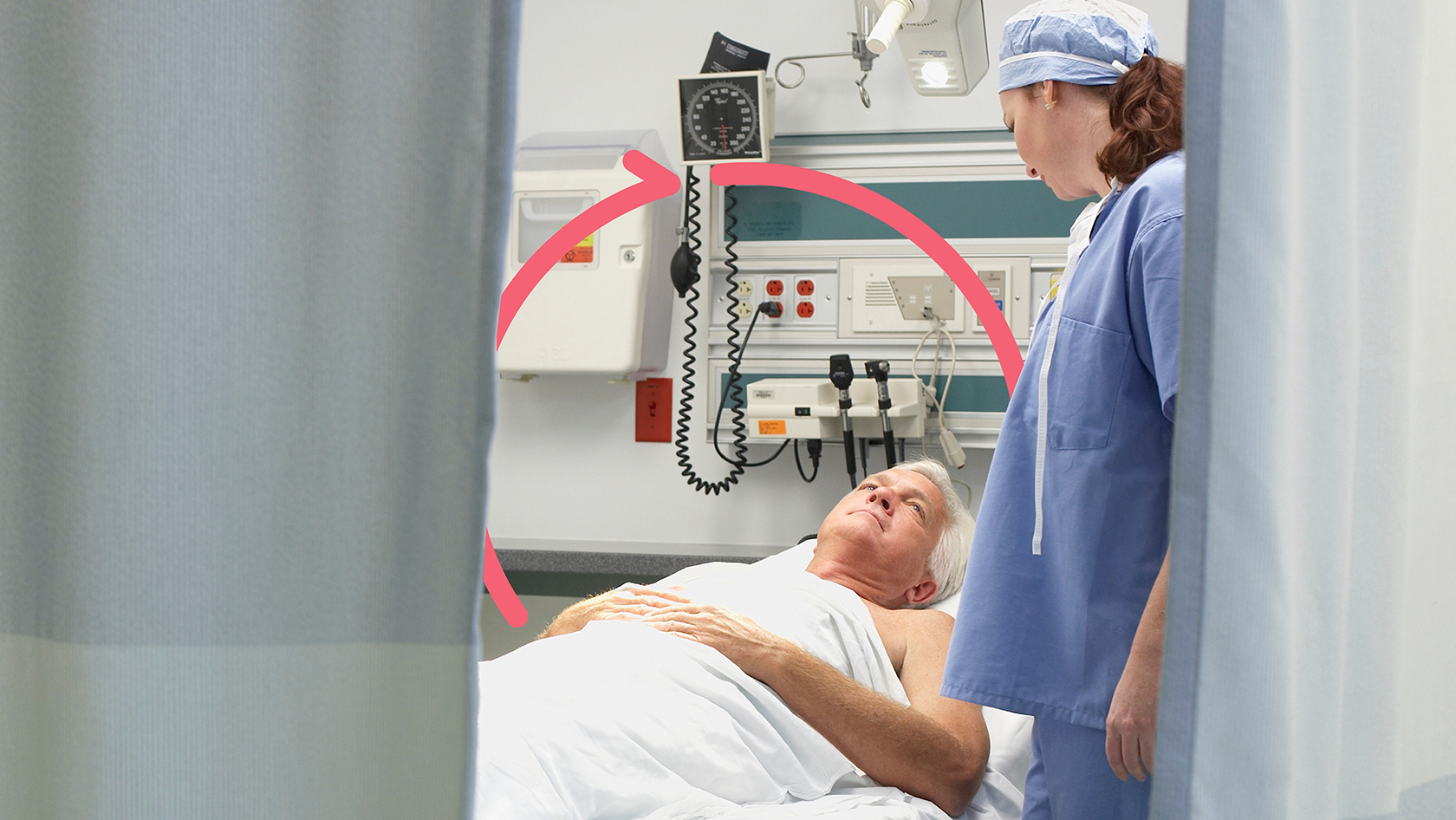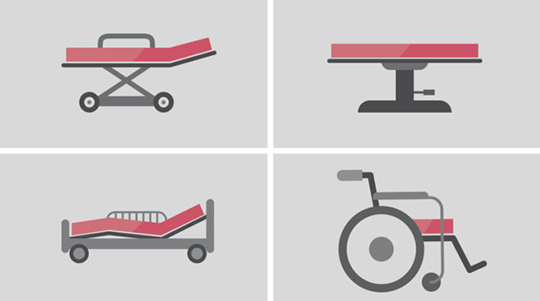Support surfaces for pressure injury prevention in the ED
7 things you can do to help protect patients.

The hospital Emergency Department (ED) is the front line of defense when it comes to pressure injury (PI) prevention.1 But it’s not easy.
- Clinicians are performing a balancing act as they manage the competing priorities in the care of seriously ill patients.1
- Patients are spending an average five hours lying on a stretcher pad.2
As if that’s not enough, there are the additional responsibilities and challenges brought on by COVID. Hospital EDs are overrun and beyond the typical demands of them, staff find themselves dealing with such matters as crowd control and mask mandates, all while treating those most in need and preventing infection in the process.
ED hallways are lined with extra stretchers that staff have had to borrow from other areas of the hospital. Patients are on support surfaces (mattresses and stretcher pads) even longer than usual waiting to be evaluated by a physician, and longer yet if they’re being admitted and no inpatient bed is available.
“Some patients are on these support surfaces for 24, 36, up to 48 hours, and if there’s anything wrong with the mattresses, it puts the patients and the hospital both at risk.”

Jackie Todd
Medline Clinical Specialist, MBA, BS, BSN, RN, CWCN, DAPWCA
Here’s what we know:
- Patients are often sitting on something that’s not designed to bear weight for long periods of time.
- Staff are not always turning or repositioning patients either because they’re stretched thin or there’s little room to maneuver.
- Under pressure to turn ED beds quickly, support surfaces aren’t always being cleaned and disinfected properly.
- In the absence of fitted sheets, staff often use flat sheets without tucking them under before a patient lies on it.
“I would lay odds that there’s been a spike in PIs in the ED, and the reason is that mattresses typically are so old and worn, they can’t adequately provide pressure redistribution anymore,” Todd says. “Even if the cover doesn’t visibly show anything, whatever gets through the mattress surface—blood, urine and other contaminates—is going to come back out when the next patient gets on that stretcher.”
While there are limited data on ED pressure injury rates1, it’s safe to assume that the risk is higher for PIs because of COVID, and the need is greater than ever to refocus and re-educate ED staff on best practices to help prevent skin breakdown and the PIs that can result.
“I would lay odds that there’s been a spike in PIs in the ED, and the reason is that mattresses typically are so old and worn, they can’t adequately provide pressure redistribution anymore.”
Jackie Todd
Medline Clinical Specialist, MBA, BS, BSN, RN, CWCN, DAPWCA
Keep these 7 interventions top of mind:
-
Drive awareness of the key factors leading to pressure injuries: prolonged pressure, friction, shear and moisture management.
-
Reprioritize pressure injury prevention, starting with four evidence-based best practices recommended by the National Pressure Injury Advisory Panel: Properly turn and reposition to keep skin healthy, manage moisture to protect fragile skin, relieve pressure at the heels, and engage a clinical consultant to help identify gaps and opportunities.
- Think of stretchers and mattresses as part of your prevention program—not as furniture. “It’s important to change this mindset,” Todd says. “This equipment is not a bedside table. It’s not a TV. It’s not part of the patient room. It’s part of what you’re trying to do to prevent skin injuries and healthcare-associated infections.”
- Protect and preserve polyurethane support surface covers by following best practices for cleansing, disinfecting and care provided by product manufacturers as opposed to cleansing and disinfectant suppliers. Failure to follow these instructions may compromise the performance of the support surface, increase the risk of patient harm and void product warranty.3
- Reinforce to staff that cleansing and disinfecting are separate processes, and that cleansing must come before3
To cleanse3: Physically remove blood and gross soiling using non-abrasive cleanses and wipes, wipe all exposed surfaces with pH-neutral detergent, and rinse thoroughly with clean, warm water and a clean cloth.
To disinfect3: Wipe all exposed surfaces with disinfectant and incubate for the recommended kill time, rinse thoroughly with clean warm water using a clean cloth or sponge, and make sure it is dry before linens are added. - Drive compliance by reminding staff how infection can spread when cleansing and disinfecting isn’t done properly, even showing them mattresses or pictures of mattresses that have become grossly soiled by bodily fluids and other contaminates. Don’t be afraid to paint a gruesome picture. “Any time anything breaches that cover, you have a petri dish for microbial growth,” Todd says. “It’s a dark place. It’s a moist place because of bodily fluids. And because of a patient’s body heat, it’s an incubator.”
- Inspect and evaluate your mattresses. Check inside for soiling and contamination that can easily seep through the cover. Dispose of stretchers and mattresses that are obviously worn. When cost is a factor, place an underpad between the sheet and mattress to reduce the risk of contamination.
When purchasing new mattresses and stretcher pads, choose products that are designed to help reduce and redistribute pressure as well as keep patients cool and dry. Consider these important factors in replacing old mattresses and stretcher pads, including: average daily census, average length of stay (LOS), average weight of patients on stretchers, and backrest elevation, which can place pressure on a patient’s sacrum.
Request a mattress assessment with an Advanced Wound Care specialist who will evaluate your mattresses, determine which ones provide adequate pressure redistribution and establish a support surface replacement plan for your facility.
Key takeaway
While the Emergency Department (ED) is the front line of pressure injury (PI) prevention, its chaotic nature has always posed challenges. Managing care is a balancing act, and patients often face long waits. COVID has raised the stakes where risk and cost are concerned, and there may be no better time than now to reprioritize pressure injury prevention. The key is to empower ED staff with knowledge, evidence-based best practices and the right system of products to help keep patients safe.
References:
- Santamaria, Creehan, Fletcher, Alves, and Gefen “Preventing pressure injuries in the emergency department: Current evidence and practice considerations” International Wound Journal, 2019 June;16(3):746-752. Available at: https://pubmed.ncbi.nlm.nih.gov/30815991/ Accessed February 9, 2022.
- Osborne A. 5 Myths About the ER, Debunked. CNN website. Available at: https://www.cnn.com/2014/04/09/health/emergency-room-myths/index.html Accessed November 9, 2018.
- “Best Practices for Cleansing, Disinfecting, and Care of Polyurethane Support Surface Covers” National Pressure Injury Advisory Panel. Available at: https://cdn.ymaws.com/npiap.com/resource/resmgr/s3i/S3i_NPIAP_Cleansing_Disinfec.pdf Accessed February 9, 2022.




